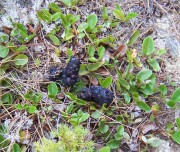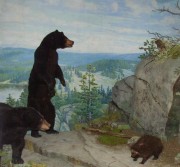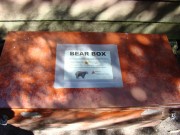text by Craig McLaughlin
Wildlife Biologist, Maine Department of Inland Fisheries and Wildlife
Bear Facts
Physical Characteristics
The black bear, featured above at the Maine Wildlife Park in Gray, is the smallest of the three species of bears inhabiting North America (black, brown/grizzly, and polar), has the widest distribution on the continent, and is the only bear living in the eastern United States.
Black bears are found in most forested areas from Mexico north to the edge of the tree line in Canada and Alaska. Although most black bears are not much larger than humans, their weight can vary tremendously with the season of the year. Bears store body fat during the fall months to supply energy during their long winter denning period, and are heaviest in late fall.
Bear Facts
- Although they appear slow and lumbering, bears can run at speeds up to 35 miles per hours?
- Bear cubs have blue eyes, which turn brown during their first summer?
- Bears may remain in their dens for 5-6 months each year in Maine. During this time they do not eat, drink, urinate or defecate?
Hunting Tips
- Successful hunters know that the best places to locate bears are at food sources. Pre-season scouting increases your success rate. Look for tracks, droppings, broken stems or branches near seasonal food supplies.
- Always ask landowner permission before setting baits or starting hounds.
- Hunt near food sources that are “in season”. Early in the fall, bears are found near clear cuts that produce berries; late in the fall, hunt near sources of beechnuts or acorns.
- Scent control is a must for successful hunting over bait. Wear rubber footwear, keep hunting clothing clean, and avoid wearing it in camp where foreign odors can be picked up. Do not smoke on stand. Use cover scent.
- Tree stands are dangerous. Secure yourself with a safety strap. Do not climb with a firearm or bow in your hand; instead, use a haul line after safely strapping yourself in.
- Practice with your weapon continuously to maintain proficiency. Bears must be hit solidly in the lungs or heart, rather small targets compared to a bear’s large body size.
- Hunting with hounds is physically demanding. An exercise program will put you in shape to complete a hunt safely.
Adult males average 250 – 600 pounds, and measure 5-6 feet from tip of nose to the tip of their tail. Females are smaller, weighing 100-400 pounds, and measuring 4-5 feet in length. Males stand about 40 inches tall at the shoulder; females seldom exceed 30 inches in height. Bears are compact, with stocky legs, small eyes, short, rounded ears, short curved claws, and a short, inconspicuous tail. The black bear has a straight facial profile and a massive skull.
Black bears in Maine are normally black , but they are often various shades of brown to cream colored in western populations, and are even white, and blue-gray in color in coastal British Columbia and Alaska. They have a brown muzzle, and occasionally a white throat or chest patch or “blaze.” Bears walk flat-footed, and their broad feet leave 5-toed tracks that sometimes resemble human footprints. Tracks of female bears rarely exceed 4.5 inches in width; males leave tracks up to 6 inches wide.
Natural History
Habitat. Black bears require forests for protection and food. They are amazingly adaptable to human presence, and are able to survive in close proximity to housing developments and suburban areas wherever cover to escape cover exists.
Food habits. Bears are opportunists, and feed on a wide range of vegetation and animal matter. They eat a variety of plant matter throughout the growing season, including early greening grasses, clover, and the buds of hardwood trees in the spring, fruits and berries in summer, and beechnuts, acorns, and hazelnuts in the fall. This diet is supplemented with insects, including ants and bees (their larvae, adults, and honey), and occasional mammals and birds.
Bears are not considered efficient predators, but they are known to prey on young deer and moose in late spring, and will consume carrion. Bears are intelligent, and adapt rapidly to new food sources, including agricultural crops and food placed to attract other wildlife, such as bird feeders, and untended garbage. Therefore, they occasionally cause problems for farmers, beekeepers and orchardists, and rural residents in the State. Feeding habits are revealed in bear feces or scat found in the woods.
Reproduction. Black bears breed from May through August, with most activity peaking in June and July. Adults are solitary, and during the summer months males travel over large areas to enhance their chances for encountering mates. Although males become sexually mature at 1-2 years of age, most do not participate in breeding until they have reached full adult size, at about 4-6 years in Maine. Females in Maine become sexually mature at 3-5 years of age. Individual females have a 2-year reproductive cycle, which is related to their long period of parental care for cubs. Bears have a long gestation period, but most fetal development is delayed until the final 6-8 weeks. Breeding occurs in the summer, prior to the fall feeding period that provides the female with stored body fat to supply demands for fetal development and her survival during the winter. If a female is unable to store sufficient body fat, the pregnancy is terminated.
Most fetal development occurs in early winter, after the female has entered a den, and 1-4 cubs are born inside the winter den during January – February. Cubs weight about 12 ounces at birth, and depend on their mother for warmth and nutrition during the remainder of the winter. They grow to 4-10 pounds by mid-late April, when the mother leads them away from the den.
The family group remains together for 16-18 months, until the female reenters estrus and disperses her yearlings as another breeding season begins. In northern Maine, fluctuating beechnut crops have produced alternating years of high and low cub production, with most cubs being born on odd-numbered years. Cub production is more consistent in central Maine, where more stable fall food supplies result in nearly half of adult females giving birth each year.
Longevity. Bears are long-lived animals, capable of surviving 30 years in the wild. Their survival increases as they mature. Nearly half of newborn cubs may die before reaching their first birthday, with starvation being a major cause of death. By the time bears in Maine reach 2 years of age their survival exceeds 90%, and nearly all deaths of adult bears are due to hunting or other man-related causes.
Movements. Black bears lead solitary lives, except for breeding pairs, family groups comprised of adult females and their offspring, and occasional aggregations at concentrated food sources. Females use areas of 6-9 square miles in Maine. They are sedentary and remain within or near the range of their mother for the duration of their lives. Males disperse long distances (often up to 100 miles) as subadults (1-4 years of age) prior to settling into adult ranges that may exceed 100 square miles.
Bears often make trips up to 40 miles outside of their ranges to feed on berries or nuts (or occasionally to an orchard or field of oats or corn) in late summer or fall. When feeding on a concentrated food source, bears may use areas as small as several acres; when searching for dispersed food or mates, they can cover several miles in a day. Bears are active in late fall as long as food is plentiful. In years of abundant beechnut crops, they will feed until snow makes travel difficult, and normally enter dens in late November. If late fall food is scarce, bears usually enter dens by mid-October.
Campers and hikers should be wary of leaving food within reach of bears. Place supplies in bags high on small trees or poles; or put them in secure “bear boxes.” The notice on this box, provided by the AMS Shelter Program, reads in part “Black bears have been seen in the area. This box has been brought here for your convenience and to protect the bears in the area. Please put all food, food waste, and any other item with a scent (i.e. toothpaste, toiletries, insect repellent, etc.) in this box.”
Historical Management in Maine
Population and Distribution Trends. Historically, bears were found throughout the State. Following European settlement, bears were extirpated from the south-coastal section of Maine, from Portland north to Penobscot Bay as forests were cleared for farming. Soils were depleted and agriculture declined since the turn of the century, and forests have re-grown and are once again able to support bears. However, bears are slow to recolonize vacant habitat, and are still rare visitors to south-coastal Maine. Most of the State has remained a stronghold for black bears.
Historical accounts suggest that population density fluctuated over the last century, but the State has always supported an abundant bear population. Interest in bear hunting increased in the 1970s, and the Department’s Bear Study was established in 1975 to monitor population status. The statewide population was estimated at 6,000-9,000 in 1979, and season restrictions were implemented to guard against overharvests. By 1984, improved information on bear densities yielded a revised statewide estimate of 18,000 bears.
The 1985 population was estimated at 21,000 bears, but renewed interest in hunting and escalating harvests during the late 1980s reduced the population to 18,000 bears by 1989. Additional restrictions on hunting season length have increased bear survival during the 1990s, and the population increased to 22,000-23,000 bears in 1998.
More Videos!
Additional resources
Maine Department of Inland Fisheries and Wildlife http://www.mefishwildlife.com
“Bears In The Backyard: What Do You Do Now?” Augusta, Me. Maine Department of Inland Fisheries and Wildlife. 2003.
Hugie, Roy Dean. Black Bear Ecology and Management in the Northern Conifer-deciduous Forests of Maine. Microfilm. Ann Arbor, Mich. University Microfilms International. 1982. Thesis (Ph. D.)–University of Montana, 1982. (available at Fogler Library, University of Maine, Orono)
Powell, Roger A. Ecology And Behaviour Of North American Black Bears: Home Ranges, Habitat, And Social Organization. London; New York. Chapman & Hall. 1997.
Smith, Dave. Backcountry Bear Basics: The Definitive Guide To Avoiding Unpleasant Encounters. Seattle, WA. The Mountaineers. 1997.




